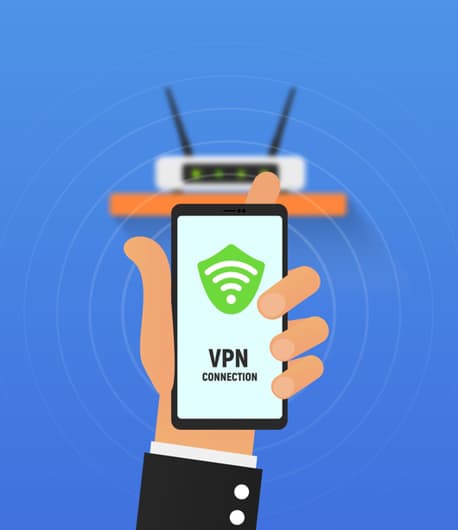
Table of Contents
What Is WiFi Eavesdropping?
WiFi eavesdropping refers to the unauthorized interception and monitoring of wireless network traffic, allowing attackers to exploit vulnerabilities in communication protocols and gain access to sensitive information transmitted over a WiFi network. This malicious activity has become increasingly prevalent with the widespread use of public WiFi networks. Public Wi-Fi networks are often unsecured, making them an attractive target for hackers who can easily intercept data packets transmitted between devices connected to the same network.
How Do WiFi Eavesdropping Attacks Work?
WiFi eavesdropping attacks work by intercepting and monitoring data transmitted over wireless networks without authorization. Attackers capture data packets using tools like packet sniffers, taking advantage of the inherent vulnerabilities in unsecured or poorly configured WiFi networks. Once the data is captured, it can be analyzed and potentially used for malicious purposes, such as stealing sensitive information or launching further cyberattacks.

Methods Used in WiFi Eavesdropping
Here are the ways through which WiFi eavesdropping attacks take place:
Man-In-The-Middle Attacks
Intercepting and manipulating data transmission through exploiting vulnerabilities in communication protocols is a common technique employed in man-in-the-middle attacks. In the context of WiFi eavesdropping, attackers can monitor network traffic between two parties without their knowledge, positioning themselves as intermediaries between legitimate users.
Unencrypted Networks
Insecure network connections can expose users to significant risks, putting their sensitive information and privacy at the mercy of potential attackers. When WiFi networks are unencrypted, it becomes easier for malicious actors to conduct eavesdropping attacks. This means that anyone within range of the wireless network can intercept and monitor the data being transmitted between devices. Without encryption, the data is sent in plain text, making it vulnerable to interception by hackers.
To better understand the implications of unencrypted networks and their susceptibility to eavesdropping attacks, consider the following:
Lack of Encryption
Unencrypted WiFi networks do not employ any form of encryption when transmitting data packets between devices. As a result, attackers can effortlessly capture and read all the information being exchanged.
Unauthorized Access
Eavesdroppers can gain unauthorized access to unencrypted networks without any hindrance. They can easily connect to the network and start monitoring all traffic passing through it.
Data Compromise
In an unencrypted network, sensitive information such as login credentials, financial details, or personal communications are transmitted in clear text format. Attackers with malicious intent can exploit this vulnerability to steal valuable data or launch further targeted attacks against unsuspecting victims.
Malware Distribution
Malware distribution poses a significant threat to digital security, as it enables the dissemination of malicious software that can compromise the integrity and confidentiality of computer systems. In WiFi eavesdropping attacks, malicious actors take advantage of unencrypted networks to distribute malware. By intercepting data packets transmitted over a public network, these attackers can gain unauthorized access to sensitive information such as login credentials or personal data. Additionally, by exploiting vulnerabilities in unencrypted networks, attackers can also obtain encryption keys used for securing communication channels and further infiltrating systems. Therefore, understanding these techniques is crucial for developing effective countermeasures against such threats and ensuring secure network environments.
Malicious Hotspots
Another technique commonly employed in WiFi eavesdropping is the creation of malicious hotspots. These hotspots are designed to mimic legitimate public WiFi networks, enticing unsuspecting users to connect and unknowingly expose their sensitive information to attackers. To better understand this type of attack, it is essential to examine its characteristics. Attackers create hotspots with names similar or identical to legitimate networks found in public places such as coffee shops or airports. Once a user connects to the malicious hotspot, all their network traffic passes through the attacker’s device, allowing them to intercept and manipulate data packets.
VoIP Traffic
Eavesdropping on VoIP communication involves intercepting and listening to conversations transmitted over a wireless network. Attackers can exploit vulnerabilities in the Wi-Fi infrastructure or compromise an access point to gain unauthorized access to connected devices and intercept VoIP packets.
By analyzing these intercepted packets, attackers can extract valuable information such as usernames, passwords, and even credit card details. Various protocols used in VoIP communication, such as Session Initiation Protocol (SIP), Real-time Transport Protocol (RTP), and Secure Real-time Transport Protocol (SRTP), may not provide adequate encryption or authentication mechanisms by default. This lack of security measures makes it easier for attackers to exploit weaknesses in the transmission of VoIP traffic and eavesdrop on confidential conversations. Therefore, organizations must implement secure measures like strong encryption algorithms and enforce strict access controls to protect their VoIP traffic from potential eavesdropping attacks on wireless networks.
Types of Wi-Fi Eavesdropping Attacks
There are two main types of WiFi eavesdropping attacks. They are:
Active Eavesdropping Attacks
In active eavesdropping attacks, the attacker plays a more intrusive role. They may inject themselves into the network communication or actively attempt to disrupt it. This can include methods like ARP spoofing or Man-in-the-Middle (MITM) attacks. The attacker intercepts and potentially modifies the data being transmitted between devices, posing a significant threat to the security and privacy of the network.
Passive Eavesdropping Attacks
Passive eavesdropping is more stealthy. Attackers simply listen to the data being transmitted over the network without actively altering or disrupting it. This can involve using packet sniffers or monitoring software to capture data packets as they traverse the network. Passive attacks are harder to detect but are generally less disruptive than active ones, as the attacker remains hidden and doesn’t tamper with the data.
How To Reduce the Risk of WiFi Eavesdropping Attacks
To mitigate the risk of unauthorized access to sensitive information, it is crucial to implement robust security measures that include strong encryption protocols and regular monitoring of network traffic in wireless environments. Here is how you can reduce the risks of WiFi eavesdropping attacks:
Update WiFi Equipment
Updating WiFi equipment regularly is essential for maintaining a secure and robust wireless network, ensuring that vulnerabilities are addressed promptly and effectively. By keeping the equipment up to date, organizations can protect against potential eavesdropping attacks and mitigate the risks associated with malicious techniques.
To achieve this, several factors should be considered:
Firmware Updates
Regularly updating the firmware of WiFi devices helps address security flaws and vulnerabilities that may be exploited by attackers seeking to eavesdrop on network communications. This ensures that any known weaknesses are patched, reducing the likelihood of successful attacks.
Security Patches
Manufacturers often release security patches to fix vulnerabilities in their WiFi equipment. Applying these patches promptly is crucial as they provide protection against new attack techniques and keep networks secure from potential eavesdropping threats.
Encryption Protocols
Updating WiFi equipment allows for the adoption of stronger encryption protocols such as WPA3 (Wi-Fi Protected Access 3). These protocols offer enhanced security features compared to older versions, making it harder for attackers to intercept and decode wireless transmissions.
Hardware Upgrades
As technology evolves, newer generations of hardware offer improved security features and performance capabilities. Updating WiFi equipment enables organizations to take advantage of these advancements, ensuring better protection against eavesdropping attempts and enhancing overall network security.
Change Default Login Details
Changing the default login details for WiFi equipment is crucial in establishing a strong security foundation by reducing the risk of unauthorized access and potential exploitation. Default login credentials are commonly known and widely available, making it easier for attackers to gain access to the network and compromise sensitive data. By changing these default credentials, users can ensure that only authorized individuals have access to their network, thereby protecting against unauthorized data breaches. Strong login credentials should include a combination of alphanumeric characters, and special symbols, and be unique to each individual user or organization. This practice adds an extra layer of protection to the network by preventing attackers from easily guessing or brute-forcing their way into gaining administrative privileges.
Enable Network Security Features
Enabling network security features strengthens the overall protection of a system by implementing additional layers of defense against potential threats.
To ensure the security of a network, it is crucial to make sure that the following measures are in place:
Encryption
By using encryption protocols such as WPA2 or WPA3, network traffic can be encrypted, making it difficult for unauthorized individuals to gain access to sensitive information.

Firewall
A firewall acts as a barrier between a trusted internal network and external networks, monitoring incoming and outgoing traffic. It helps detect and block any abnormal activity that may indicate an attempted intrusion.
Intrusion Detection System (IDS)
An IDS monitors network traffic for suspicious behavior or known patterns of attacks. It alerts administrators if any unusual activity is detected, allowing them to respond promptly and prevent unauthorized access.
Access Control
Implementing strong authentication mechanisms like usernames, passwords, and two-factor authentication ensures that only authorized users can easily access the network resources while keeping out potential attackers.
Note:
By incorporating these essential network security features, organizations can significantly reduce the risk of unauthorized access and protect their systems from potential threats posed by malicious actors seeking to exploit vulnerabilities in wireless networks.Use Strong, Unique Passwords
Utilizing robust and unique passwords is imperative in fortifying network security, as it enhances the resilience of authentication mechanisms and mitigates the potential risks associated with unauthorized access to sensitive information. Strong passwords consist of a combination of upper and lower-case letters, numbers, and special characters, making them difficult for hackers to crack using brute force or dictionary attacks. By employing strong passwords, individuals can protect their websites and online accounts from being compromised. Furthermore, using unique passwords for each website or service adds an extra layer of security, as it ensures that if one password is compromised, attackers cannot gain unauthorized access to other accounts. It is crucial to avoid using easily guessable information such as birthdates or common words in passwords, as hackers often employ sophisticated techniques like social engineering to guess or obtain this information.
Implement MAC Address Filtering
MAC address filtering plays a crucial role in securing communications within a network. By configuring the router or access point to only allow connections from known MAC addresses, it becomes significantly harder for an attacker to gain unauthorized access and intercept sensitive information. This technique adds an extra layer of security as it ensures that only trusted devices are connected to the network, minimizing the chances of potential attacks exploiting vulnerabilities in poorly secured devices. However, it is important to note that this method alone may not provide complete protection against sophisticated attackers who can spoof or clone MAC addresses.
Disable Remote Management
Remote management allows administrators to access and control network devices from a remote location, but it also introduces a potential entry point for attackers. By disabling this feature, organizations can mitigate the risk of compromised systems being used as launching pads for further attacks. This measure prevents unauthorized individuals from gaining control over network devices, reducing the likelihood of sensitive information being intercepted during transmission.
Moreover, it limits an attacker’s ability to exploit any existing vulnerabilities in the device’s firmware or software through remote channels. Therefore, disabling remote management plays a vital role in safeguarding networks against WiFi eavesdropping and other malicious techniques by minimizing attack vectors and strengthening overall security posture.
Use a VPN for Added Security
A VPN creates a secure and encrypted connection between the user’s device and the internet, thus ensuring that any communication or data transmitted over the WiFi network remains confidential. By routing all internet traffic through a VPN server, it becomes extremely challenging for malicious actors to intercept or decipher the information being exchanged. This added layer of security provided by a VPN is particularly crucial when conducting online activities that involve sensitive information, such as financial transactions or accessing personal accounts. Implementing a VPN not only safeguards against potential threats posed by WiFi eavesdropping techniques but also offers protection against other malicious techniques that may be employed by hackers during their deep dive into compromising network security.

Be Cautious With Public Wi-Fi Networks
When using public Wi-Fi networks, exercise caution, as they often lack robust security measures. These networks can be vulnerable to various cyber threats, including eavesdropping and data interception, so it’s advisable to avoid transmitting sensitive information or use a virtual private network (VPN) for added security when connecting to such networks.
Frequently Asked Questions
Is WiFi Eavesdropping Limited To Specific Types of Networks?
WiFi eavesdropping is not limited to specific types of networks; it can potentially occur on any wireless network that uses the WiFi standard. Both public and private networks are susceptible to eavesdropping if they lack proper security measures, making it essential for all WiFi users to be vigilant about their network security.
Can WiFi Eavesdropping Attacks Be Conducted Remotely?
Yes, WiFi eavesdropping attacks can be conducted remotely. Attackers can use various techniques such as sniffing, packet interception, and man-in-the-middle attacks to capture and analyze wireless network traffic from a distance without physically accessing the target network.
Are There Any Signs or Indicators That My Network Is Being Eavesdropped On?
Signs of network eavesdropping include unexpected drops in speed or performance, unusual network activity, strange behavior on connected devices, and unexplained data usage. Network Monitoring and using encryption can help detect and prevent eavesdropping.
How Can I protect My VoIP traffic From WiFi Eavesdropping Attacks?
To protect VoIP traffic from WiFi eavesdropping attacks, encryption protocols such as Secure Real-Time Transport Protocol (SRTP) and Virtual Private Network (VPN) can be employed. These technologies ensure the confidentiality and integrity of the transmitted data.
Conclusion
WiFi eavesdropping poses significant risks in terms of privacy and data security. Understanding the techniques employed by attackers is essential in order to defend against these threats effectively. By implementing robust security measures and staying vigilant about potential vulnerabilities, individuals and organizations can reduce their risk of falling victim to WiFi eavesdropping attacks.

